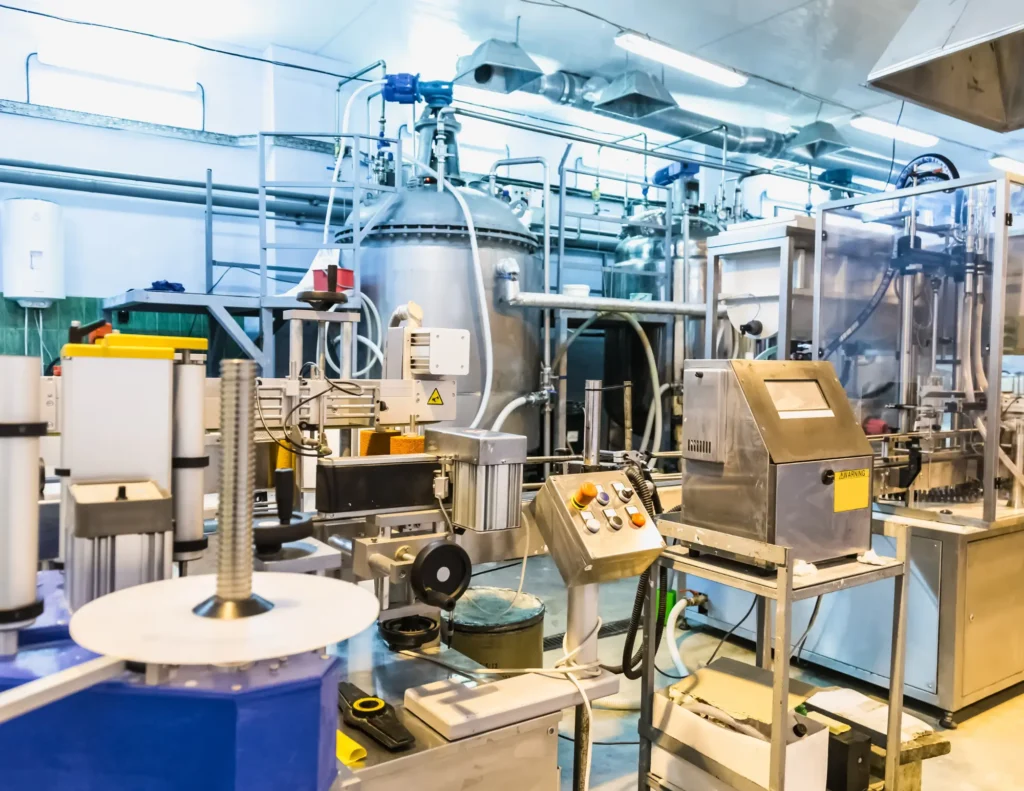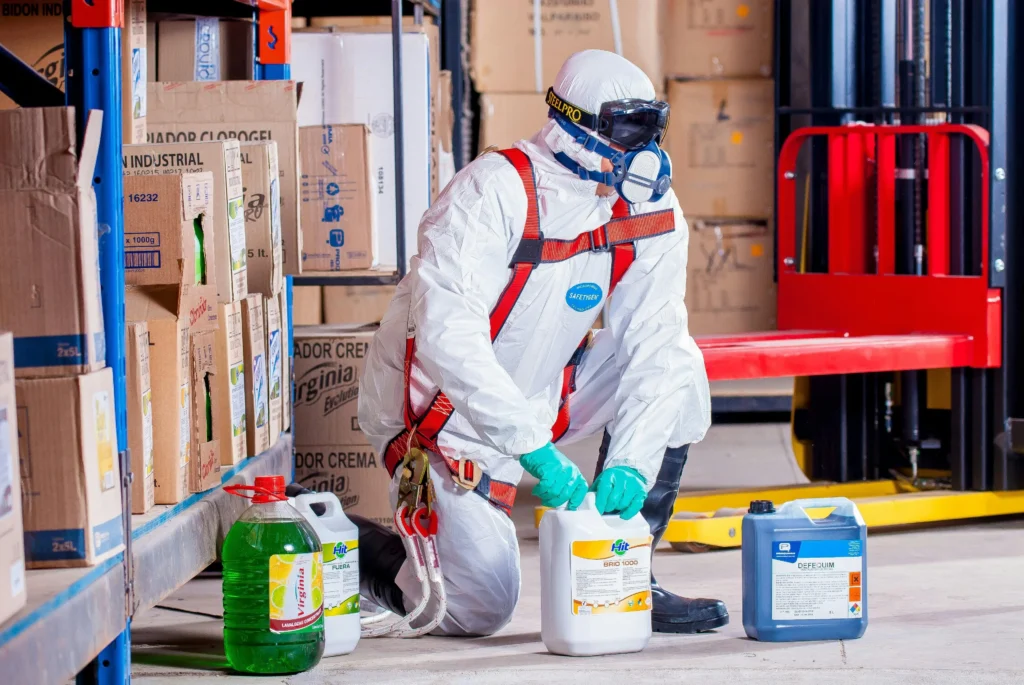Storing chemicals right is crucial to keep your home or storage safe and organized.
Improper storage can lead to accidents, spills, and even health risks. In this post, we’ll dive into practical tips for storing cleaning chemicals the right way.
You’ll learn how to keep them out of reach from kids and pets, and why labeling matters. Let’s make your storage a safer place by mastering these simple storage hacks.
Key Takeaways
- Know Chemical Safety: To Store Cleaning Chemicals first you need to learn about the dangers of each chemical you use. This helps you handle them safely.
- Create Safety Programs: Set up clear rules and training for everyone handling chemicals. This keeps everyone informed and safe.
- Pick the Right Storage Spots: Store chemicals in places that are cool, dry, and away from direct sunlight to avoid reactions.
- Organize Chemicals Properly: Keep chemicals in their original containers with labels. Group similar chemicals together to prevent accidents.
- Keep Storage Areas Clean: Regularly check and clean storage areas to ensure they stay safe and organized.
1. Basics Of Chemical Safety
1. Recognizing Hazards

Cleaning chemicals can be corrosive or toxic. Corrosive chemicals can eat away at materials and skin. Toxic ones can harm our health. It is important to know these risks.
Incompatible chemicals can react dangerously when mixed. For instance, mixing bleach with ammonia creates toxic gas. Always check which chemicals should not be stored together.
Look for signs of chemical deterioration. Containers may leak or bulge if they are damaged. These signs mean the chemicals inside could be unsafe.
2. Accessing Safety Data Sheets
Safety Data Sheets (SDS) provide crucial information about cleaning chemicals. They describe properties, hazards, and safety measures. Make sure everyone can easily access these sheets.
Review SDS regularly for updates on handling and storage procedures. Sometimes, new information becomes available that you need to know.
Train staff on how to read SDS. They should understand first-aid measures and what to do in case of spills or leaks. This knowledge helps keep everyone safe.
3. Correct Labeling Practices
Keep original labels on all chemical containers. These labels provide clear hazard communication. They tell you what dangers the chemicals pose.
Use secondary labels when transferring chemicals to new containers. These labels should include hazard information and usage instructions. This practice prevents accidents.
A good chemical labeling system helps avoid misuse or mixing of chemicals. It ensures everyone knows what each container holds and how to handle it safely.
2. Implementing Safety Programs

1. Training Staff
Regular training keeps everyone safe. Employees should know how to use, store, and dispose of cleaning chemicals correctly.
Practical demonstrations help a lot. Show how to read labels and Safety Data Sheets (SDS). Teach them what to do in an emergency.
Continuous education is key. Chemical safety standards change over time. Keep staff updated on new storage protocols and safety measures.
2. Educating on Storage Protocols
Storing chemicals by their hazard classification is important. This prevents dangerous reactions between different chemicals.
Use a first-in, first-out system. This means using older stock before newer stock. It helps avoid using expired chemicals, which can be unsafe.
Segregate cleaning chemicals from food items and personal belongings. This reduces the risk of contamination and improves employee safety.
3. Choosing Storage Locations
1. Ideal Sites for Chemicals
Select a storage location with a controlled temperature. Avoid places that get too hot or cold. Ensure the area has good ventilation. This helps prevent fumes from building up.
Keep chemicals away from direct sunlight. Sunlight can cause some chemicals to break down or become dangerous. Store them in a cool, dark place instead.
Do not store chemicals in areas accessible to unauthorized personnel or children. A locked cabinet or room works best. Safety is important.
Inspect storage areas regularly. Check for leaks, spills, or any signs of damage. Make sure all safety standards are met. Regular inspections help identify potential risks early.
2. Using Safety Cabinets
Safety cabinets are useful for storing flammable and combustible chemicals. These cabinets keep chemicals secure and reduce fire risks.
Grounding and bonding cabinets prevent static-induced explosions. This is important when storing flammable substances. Grounding connects the cabinet to the earth, while bonding links it to other equipment.
Choose cabinets with built-in ventilation or spill containment features. Ventilation reduces harmful vapors inside the cabinet. Spill containment catches leaks before they spread.
4. Organizing Chemicals Safely
1. Safe Organization Tips
Create a color-coding system for cleaning chemicals. Use clear signage to categorize by hazard class. This helps identify hazardous chemicals quickly.
Keep the storage area clutter-free. This reduces the risk of accidental spills or leaks. Make sure everything has its place.
Use shelving units designed to contain spills. These shelves make cleanup easier. They also prevent chemicals from mixing.
2. Securing Supplies Properly
Use anti-roll lips or barriers on shelves. These prevent containers from falling. This is important for flammable materials and other dangerous cleaning products.
Store heavy containers at lower levels. This minimizes the risk of injury during retrieval. It also reduces the chance of spillage.
Lock storage areas to restrict access. Only authorized personnel should enter these areas. This ensures a strict chemical safety program.
3. Ventilation and Temperature Control
Ensure proper ventilation in storage areas. Good airflow prevents the buildup of harmful fumes. This is crucial for storing many cleaning chemicals.
Control the temperature in storage areas. Some chemicals are sensitive to heat or cold. Keeping a stable temperature prevents accidents.
5. Maintaining Storage Areas
1. Handling Containers
Wear appropriate personal protective equipment (PPE) when handling chemicals. This includes gloves, goggles, and aprons.
Open, pour, and seal chemical containers carefully. Avoid spills and exposure by using funnels and spill trays.
Check containers regularly for leaks or damage. If a container is compromised, report it immediately and isolate it from other chemicals.
2. Managing Portable Safety
Label portable containers clearly with chemical names, hazards, and concentrations. This helps prevent accidents and misuse.
Use spill kits and PPE when transporting chemicals between storage and use sites. This reduces the risk of spills and exposure.
Designate an area for returning portable containers after use. Ensure they are properly stored and not left out.
6. Closing Thoughts
You know how to keep cleaning chemicals safe. With safety programs and good storage, you can keep things running smoothly.
As a Chemical manufacturer, we provide all the things you need to know about storing chemicals. Now, it’s your turn to take action. Check your storage areas and make changes if needed. Have any tips? Share them with your team. Safety starts with you but helps everyone. Let’s make every workspace safer!
7. Frequently Asked Questions
1. What are the key aspects of chemical safety?
Chemical safety involves knowing the hazards, using proper protective gear, and following guidelines. Think of it as having a recipe for safe handling.
2. How do I start implementing a safety program?
Begin by training your team. Make sure everyone knows the risks and safety protocols. It’s like teaching everyone to read a map before they go on a hike.
3. Where should cleaning chemicals be stored?
Store them in a cool, dry place away from direct sunlight. Imagine finding a shady spot for your picnic; it’s about keeping things safe and sound.
4. How can I organize chemicals safely?
Label everything clearly and keep incompatible chemicals apart. It’s like organizing your closet – you wouldn’t mix socks with shoes.
5. Why is maintaining storage areas important?
Regular checks prevent accidents. Think of it like tuning up a car; maintenance keeps everything running smoothly.
6. Can I store all the cleaning chemicals together?
No, some chemicals react badly when mixed. It’s like storing fireworks next to a campfire – not a good idea!
7. What should I do if there’s a chemical spill?
Follow your emergency plan immediately. Clean it up safely and quickly, just like you’d mop up a spilled drink before it spreads.



